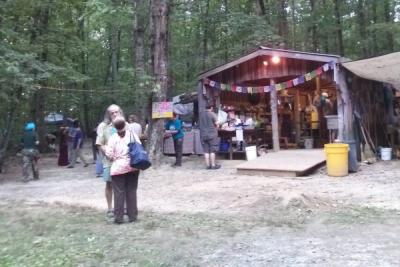
 Last year, in December 2013, my daughter decided to visit Twin Oaks, a long established, egalitarian income sharing community in Louisa, Virginia. Her hope was to find a community that would support her commitment to living sustainably, connecting with the earth on a spiritual level, and supporting her egalitarian cooperative values. Her initial reports were tentative, “Is this how I want to live my life?” “Can I imagine making my life with these strangers and their unfamiliar norms?”
Last year, in December 2013, my daughter decided to visit Twin Oaks, a long established, egalitarian income sharing community in Louisa, Virginia. Her hope was to find a community that would support her commitment to living sustainably, connecting with the earth on a spiritual level, and supporting her egalitarian cooperative values. Her initial reports were tentative, “Is this how I want to live my life?” “Can I imagine making my life with these strangers and their unfamiliar norms?”
By the end of her visit, she indeed decided she wanted to apply for membership. As I drove her down to begin her new life at Twin Oaks, she still was questioning her decision. When we got there she proceeded to cry sitting on what would become her new bed. “What am I doing here?” she asked not really expecting me to answer. It didn’t take long for her feelings of uncertainty to change. A week later we spoke on the phone and she was enjoying herself, adjusting to her new community, forming relationships and exploring her spiritual connections to the land and community.
By the time I visited her in June, she was solid in her decision and a true believer in simple and communal living. I left that visit happy for her and more than just a little envious. I pulled out of the Twin Oaks roadway, passing the fenced in cows and lovely vegetable gardens, wishing that I too could find my tribe and live communally. I also wanted to live according to my values and to be part of a movement that challenges the wasteful isolation of the typical consumer-driven middle class lifestyle. At the time, I was in graduate school studying for my Masters in Social Work and every chance I got I wrote and spoke about building community as the antidote to many of our social ills.
At the Twin Oaks Communities Conference in September, I was given the opportunity to facilitate a conference workshop on elder/hospice care in intentional communities. I also had begun working with Point A, a collective looking at developing more urban based egalitarian, income sharing communities. By this time I was certain that I wanted to find a NYC based community so that I could continue co-parenting my 12 year old daughter with my ex-husband who is based in Brooklyn. I journeyed to the conference hoping I would find “my tribe” or at least be pointed in the right direction.
 Prior to facilitating the elder/hospice care workshop at the conference, an organizer from Twin Oaks suggested I research current communities offering elder care. I visited Ganas, a Staten Island intentional community of 75 people. This community is providing elder care to some of its members. I went to one of their Friday night visitor dinners to learn more . The dinner conversation was fun and interesting. I asked questions and in return members of Ganas asked me questions as well. Afterward I was given a tour of the community and was impressed with their warm and welcoming vibe.
Prior to facilitating the elder/hospice care workshop at the conference, an organizer from Twin Oaks suggested I research current communities offering elder care. I visited Ganas, a Staten Island intentional community of 75 people. This community is providing elder care to some of its members. I went to one of their Friday night visitor dinners to learn more . The dinner conversation was fun and interesting. I asked questions and in return members of Ganas asked me questions as well. Afterward I was given a tour of the community and was impressed with their warm and welcoming vibe.
I told the conference planners that I would be more than happy to give anyone from NYC a lift. On the way down I shared the ride with a man who has lived and worked for Ganas for a number of years. It was so interesting hearing about his life in this well established community. The shared meals, the mixed economy, the conflicts, both resolved and unresolved, made for good stories. It seemed as though he felt enriched by what he enjoyed about living in community, as well as its trials and tribulations.
When we arrived at Twin Oaks, we met up with my daughter who was helping with room assignments, coordinating child care, and helping with registration and other assorted tasks. The conference planning was truly par excellence. The organizers had thought everything through which is no easy task. The conference site and campgrounds included a kitchen, dishwashing station, showers and portable toilets along with the various meeting spaces and child care. They even remembered to sell flashlights so people could find their way in the dark.
From the moment I got there, I was put to work helping with whatever needed to be done. Of course it felt like we were all being bounced around from one task to the next. Volunteers were needed to help with registration, make coffee,wash lettuce, help with child care, etc. There was always something that needed to be done and those willing to do it. One woman was charged with the task of making guacamole from what seemed to be an exorbitant amount of donated avocados. While working side-by-side with my fellow conference participants I learned that important connections are formed while doing service that benefits the community. It is also how communities thrive and survive. Without sharing the workload, people miss out on building relationships and without many hands making light work, community is not really sustainable.
The workshops, panel discussions and trust building exercises provided key information for those of us wanting to join, form and/or maintain intentional community. There were many workshops to chose from, but I wanted to learn more about methods of generating income, anti-oppression work, polyamory, and co-operative housing/working. These structured discussions helped me to clarify how I wanted to proceed with my dream of wanting community. But the downtime was equally meaningful. Singing in the woods, sitting at the bonfire, waiting for coffee, all these encounters helped me to network with people who I continue to stay in touch with and who helped me work through my personal obstacles in making this radical life change that I desired. The biggest fear I struggled with was what if I don’t like it? The biggest lesson learned at the conference for me was that there are many ways to live in intentional community. You can try and try again because the world of community seekers is large enough and diverse enough for one to find their tribe.
Driving home with my collection of names and email addresses, I contemplated the question of not if, but when, I would move to an intentional community? I also debated in my head the question of whether to start a new community or join an existing one. Eventually I made up my mind to return and live at Ganas. The memory of that warm and friendly visitor meal and beautiful hilltop setting stayed with me. It literally took only minutes for me to feel comfortable after moving there. I think this is because of all the groundwork laid before making up my mind to join. The research for my workshop, the drive to and from the conference, the 4 days of attendance and the sweet feeling of connection made me certain that this is how I wanted to live.
When I think of what makes for a good conference, I think about the feeling one gets after going to a “good” one. It is a feeling of having been guided in the right direction. Great conferences make you feel transformed and that is precisely what I felt as I returned my rental car. I felt strongly that I wanted to be part of the intentional communities movement. Two weeks later I contacted Ganas and paid my membership dues feeling confident that I made this decision in a thorough and grounded way.
If you are thinking about living in an intentional community, I strongly recommend attending the communities conference. Whether you chose to follow through or not, delving deeper into learning about cooperative living with other like minded community seekers is well worth your time.
Go to the Intentional Communities and Solidarity Economics theme page
Go to the GEO front page
Citations
Aurora DeMarco (2014). Finding My Tribe at the 2014 Twin Oaks Communities Conference. Grassroots Economic Organizing (GEO). https://geo.coop/story/finding-my-tribe-2014-twin-oaks-communities-conference

Add new comment